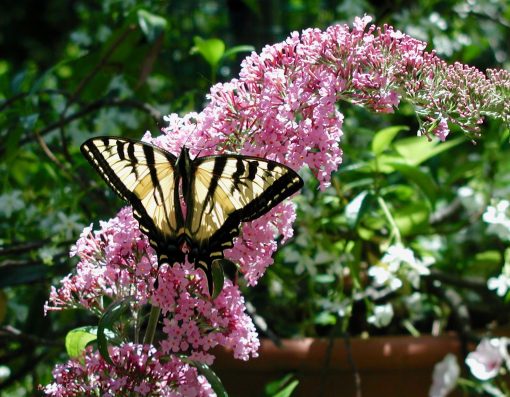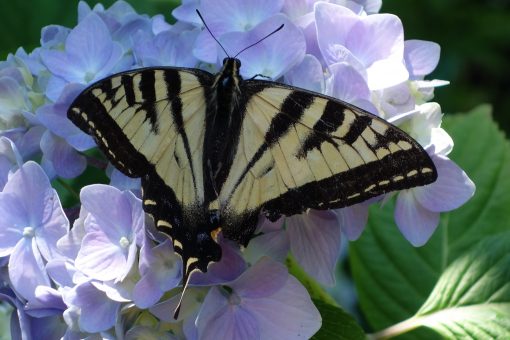
I live on Boulder Creek where the steep banks are covered with blackberries. The Himalayan blackberry has choked out the native species here but the swallowtail butterflies visit the white flowers regularly to harvest nectar. Later in the summer they will relish the ripe berries. Although I wish the blackberries were the native Pacific blackberry I do enjoy the birds and butterflies that enjoys them.
Summer butterflies live only for a week or two. During that time the butterflies mainly search for food and a mate. They have a keen sense of sight, smell and taste. Having large eyes they can see many colors including those in the ultraviolet range that we can’t see. Many flowers have ultraviolet patterns that butterflies find especially attractive. Butterflies can detect movement better than we can. If you’ve tried to get a photo of one in your garden you know how hard it is to sneak up on one.
In addition to chemical receptors on their antennae, butterflies can taste food with their tongue and even their feet. They have thousands of dusty scales that cover their wings and body and absorb heat. They can make their wings tremble to speed up the warming process and even orient their wings to the sun to absorb heat more quickly.
We have about 90 species of butterflies in the Monterey Bay area. Many of these occur only in our mountains, forests and chaparral environments. They are easy to attract and make a permanent feature in your landscape. Here’s how.
A butterfly garden should include plants that accommodate all stages of the life cycle – egg, larvae, pupa and adult . When both adult nectar and larval host plants are available, they will attract and support a butterfly population. In addition to the right plants, your garden should also have sun, a water source, protection from wind and plants in clusters. When maintaining your garden avoid the use of insecticides, including BT.

As adults, most butterflies feed on the nectar of flowers. Some local butterflies, like the Mourning Cloak and Red Admiral, feed primarily on rotting fruit or tree sap for moisture and nutrients while the California Sister feeds on aphid honeydew.
In the larval stage, most butterfly species are limited to a single plant family and occasionally a single genus. To attract more Western Tiger Swallowtails, for instance, provide larval host plants such as willow, sycamore, alder, big leaf maple, sycamore, plum and ash. Common Buckeye lay their eggs on mimulus and verbena while California Sister use the coast and canyon live oak. Planting a variety of grasses and shrubs like ceanothus, buckwheat, coffeeberry, bush lupine,manzanita and perennials like redwood violet, California aster and wallflower will attract a variety of local butterflies. If your garden is near a wild area that naturally supports the caterpillar stage, you can plant just the nectar plants to attract butterflies to your garden.
Filling your garden with nectar producing flowers is the fun part. Adult butterflies rely on sugar-rich nectar for their daily fuel. Different species have different flower color and shape preferences. Many butterflies produce scents that attract the opposite sex and many of these scents smell like the flowers that they are attracted to and visit. The scent of these butterfly-pollinated flowers may have evolved as an adaptation to ensure their survival.
Butterflies typically favor flat, clustered flowers that provide a landing pad although larger butterflies can feed on penstemon and salvias while hovering. Unlike bees, butterflies can see red and are attracted to brightly colored flowers. Pink, red, orange, yellow and purple are the most attractive nectar source flower colors but they also use blue and white.
Consider the blooming time of each plant. Having plants blooming in the sun for many hours in the day will lengthen your viewing time. Nectar rich flowers include yarrow, aster, verbena, scabiosa, buckwheat, toyon, salvia, erysimum, zinnia, lantana and coneflower.
In addition to nectar, butterflies need a source of water and salts. A patch of mud kept wet year round or a shallow depression lined with pebbles and kept moist will work fine. Also provide some flat rocks for them to bask in the sun in an area protected from the wind by shrubs.
Having a garden filled with birds, bees, butterflies and other pollinators is fun and easy.
